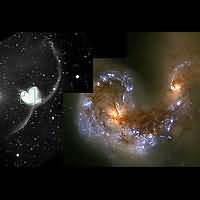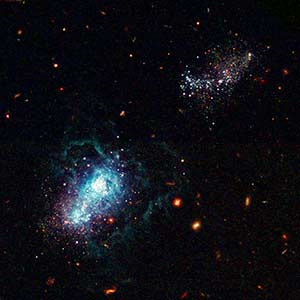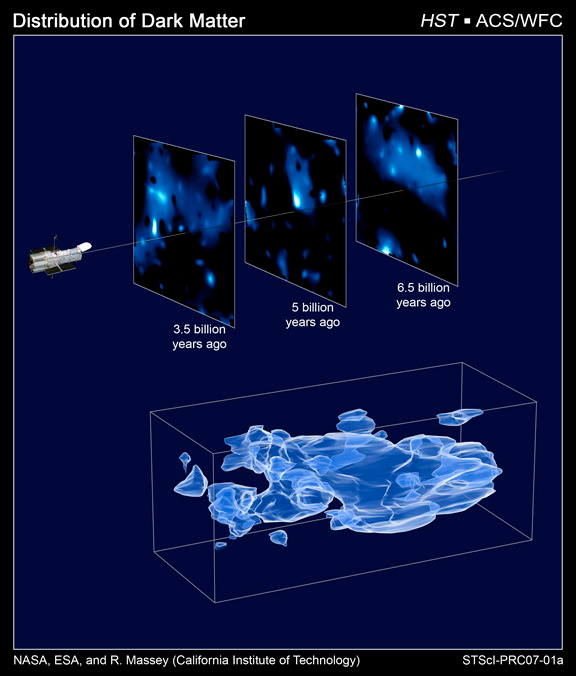There are several theories that have been put forward to explain the origin of the universe, and galaxies in particular. New theories are emerging due to the advances in astronomical observations based on the state-of-the-art computerized simulations as well as high-tech telescopes such as the Hubble. Galaxies are like the building units of the ever expanding universe. In accordance with the Science Daily, each of the galaxies is held by a spherical halo which is made of dark matter that can only be detected through its massive gravitational pull. The exact nature of the dark matter still remains a mystery to cosmologists and astronomers.
The galaxy formation and its evolution subject have advance in the last decade with new discoveries and innovations in the computerized hardware and simulations. There exists two breeds of galaxies namely the spiral galaxy and the elliptical galaxy. The Milky Ways which is a form of the spiral galaxies are the gyrating disks commonly loaded with hydrogen gas. Thus, they constantly form novel stars that (Science Daily 1).
The lately formed stars tend to bestow blue streaks to spiral galaxies. Conversely, the elliptical galaxies are composed of aged red stars which appear to lack the vital hydrogen gas. In fact, such stars contain huge and extra curved fashioned cadaver of the previous aged stars. Nevertheless, numerous efforts geared towards comprehending how such sorts of galaxies became into being seemed to pose challenges to the fresh cosmological investigators.
The formation of all galaxies was almost at the same time that is a bout thirteen billion years ago. The basis as well as development of the current galaxies over quite a period of time (billions of years) still persists to be dynamic study field both in astronomical and cosmological science. Various theoretical models have been proposed while advances in technology have lead to the discoveries that has led to the development of new theories. The most acceptable models for the formation of galaxies have been two types, the gravitational instability picture and the cosmic turbulence theory (Jones 1).
From the gravitational instability picture, galaxies are formed from huge clouds of gases often larger than the galaxy that is to be formed. The gas clouds coalesce due to the stronger gravitational pull that built within. (Strobel 1). Strobel in addition emphasizes that provided the gas clouds swivel at a very low pace, then any subsiding cloud would form most its ensuing stars prior to the shaping of the falling clouds into flattened disk (1). This produces the elliptical galaxies. On the other hand, the rotation of the gas clouds at an elevated speed would cause the subsiding gas clouds to produce a variety of its emanating stars subsequent to development of the compacted disk. The end product becomes the spiral galaxy. The kinds of a galaxy at times can be settled on depending on the speed at which the tars are created within it (Strobel 1).
The present variation of the model indicates that there were extra large clouds of gas that ended up into smaller fragmentations each forming a galaxy. This could be the reason why the galaxies are grouped into clusters (Oegerle et al., 65).
However, the super-clouds take a very long time before they collapse or fragment into individual galaxies. According to this theory the galactic formation should continuously exist. However, the invention of the young galaxies whose formation initiated the development of stars some 500 million years back has definitely proved that. The theory further asserts that the galaxies originate from these streams of invisible gases (Strobel 1). With the new galaxies, the dark matter together with the cold gases get compressed enough to form new stars. Based on Strobel (1) these newly formed galaxies are dark and extremely hard to see.
Another supplementary model claims that galaxies erected from diminutive gas tufts of approximately a million astral heaps in magnitude. In essence, this hypothetical replica avers that such gaseous tufts could have instigated subsiding at the time when the earth or cosmos was in the impulsive formation stage. The galaxies are pulled together into clusters which are subsequently drawn again into super-massive clump by gravitational impact (Strobel 1). To attest the mock-up model, there is an expectation that there ought to be various minor galaxies as compared to the bigger galaxies that have truly examined. Moreover, the galaxy clusters and super clusters should be continuously forming which again has been observed to be true.
The most tolerable speculative replica now proposed have furthermore borrowed this fundamental thought where galaxies formation occurs due to the subsiding of spherical gas which fall into a hub disk. This then preceded by the amalgamation or crash of such disks (Science Daily 1). It is imagined that the formation of stars takes a much slower pace in the presence of the gaseous disks and particularly when the disks become transformed into globes while they emerge. The explosive gas clouds form numerous stars at a high rate almost several hundred solar masses annually (Science Daily 1).
The scrutiny of what happened in the galaxies has been made achievable with the use of advanced and more powerful telescopes. This has created a vacuum of knowledge in the model. The criticisms have been centered on how these galaxies were capable of forming new stars at a higher rate in the absence of the galactic mergers (Science Daily 1). As a result of these observations scientists have come up with modern theory that explains the formation of galaxies without the massive galactic mergers.
Modern scientists who research into the formation of galaxies also explore the impact that collisions and mergers have in the structures of galaxies. There is huge inter galaxies distances but compared with their sizes then is considerable. (Faure and Mensing 35). The collision of galaxies does not necessarily mean that their stars also collide. Indeed, the huge distances prevent the star-star collision. (Sparke and Gallagher 313). Galaxies’ collisions seem to take lengthy time. Hence very powerful machines such as computers have been utilized to inspire gravitational contacts amongst the existing galaxies. See figure 1 below for galaxy collisions.

The clashes of stars are almost absent whenever there is a merger of galaxies. This is due to the greater distances that are between the stars approximately millions of light years. But the galactic collisions, in most cases, change the orbit of the stars due to the gravitational effect. A change that takes place when two galaxies comes closure is caused by the gravitational pull (Oegerle et al., 65). Automated simulations illustrate that the coiled section of the bigger disk galaxy become prompted by the minor galaxies which appear to near it.
The crashing galaxies structure into long arcs of exposed galaxies. This implies that several galaxies that collide become distorted to form antenna which takes the long-arc shapes. Some cases of collisions have smaller galaxies punching holes in the larger galaxies when they collide head on. The stars seem not to be smashed in such instances while other stars orbiting the bigger galaxies become budged to form rings just about the condensed core. Most of these galactic collisions are normally gentler and takes a long period of time. At times the galaxies merge under such conditions.
Simulations prove that elliptical galaxies are formed when two or more galaxies collide or merge. Mostly, dim groups of stars are identical with the merged elliptical galaxies. Also, at the center of these clusters, there are numerous elliptical galaxies. The absence of interaction in the spiral galaxies outer rings explain why their shape remains even after the collisions and mergers. This is the explanation why the spiral galaxies maintain their shape even after the merger with another galaxy. (Faure and Mensing 35).
Some Satellite galaxies are about to be swallowed by the Milky Way. The dwarf galaxy is indistinct and drawn-out by the tidal wave of gravitational pull of the Milky Way. Another dwarf galaxy, the carnis major is at the advanced stage of being digested or swallowed by the Milky Way, just its nucleus is what is remaining. Se figure 2 for the formation of dwarf galaxy.

The massive elliptical which are commonly found next to the galaxies hub are alleged to emerge from the crashing and integration of the existing galaxies. Such massive elliptical might significantly grow larger to absorb the closest galaxies (Strobel 1). To the current astronomers, such a process is always dubbed as galactic cannibalism. These giant elliptical will have several bright concentrations primarily not at the center. The bright spots are the foundation of the absorbed galaxies (Strobel 1).
The clouds of gases that are found within the galaxies extend widely and hence will very possibly coalesce with the gas cloud of the incoming colliding galaxy. (Faure and Mensing 35). When gas clouds batter each other, a compression usually exists and for this reason, they subside to form various stars within a short duration. Most of the galaxies which are very luminous have higher rate at which the stars within them forms (Strobel 1).
New theories are currently emerging and one of such theories explain that galaxies are largely formed as a result of intensive cosmic streams of cold gas, mostly helium and hydrogen (Science Daily 1). The streams of cold gas follow the cosmic web filament that characterizes the large scale structure of matter in the universe (Longair 227). The cosmic web filaments are the ones feeding the dark matter halos. The streams of cold gas have the capability of going through dark matter corona of the galaxy. As a result of the gravitational pull they break into huge clusters in which the hot gases efficiently change into stars (Science Daily 1). The movement of these huge clusters contributes to the elliptical galaxies formation (Science Daily 1)
Astronomers are today exploring theories that tend to combine all the models that have been proposed. The new theoretical models also take into consideration the role of dark matter currently theorized to make huge chunk of the universe (Miller 1). Forces of gravity combine Massive clusters of the invisible matter into a network of filaments. Galaxies are formed in the interconnection points of the filament. The places that encompass high concentration of the dark matter will have the rapid formation of the stars to form the elliptical galaxies (Miller 1). Both the spiral and dwarf galaxies will always exist in the regions of low dark matter concentration density.
These theoretical forms indicate that at these intense parts of the invisible matter are the most glowing parts of the galaxies. Some of the huge dark matter chunks may have cold helium and hydrogen gas that make the dark and invisible galaxies (Miller 1). The dark matter and the cold gases in these regions have not concentrated enough to spur the formation of the stars.
Scientists have been probing the distribution of the dark matter over the larger expanse of the space and in greater depth. By fiscal year 2007, the publication of a diagram (map) showing the dark matter was ready. The production of the map occurred at an elevated resolution and it showed that the concentration of dark matter increases as time goes by. Furthermore, the chart drew attention to what took place nearly halfway back since the earth originated. With the map scientists could easily show that the visible matter is clumping at the very dense places of the dark matter filaments (Strobel 1). The measuring of dark matter in space can be done by filtering light that comes from the visible matter (Strobel 1). See figure three below: Figure 3

Also in the center of the galaxies are the super massive black holes. Astronomers continue to discover that there is close relationships between the black hole and the galaxies (Miller 1). The debate among the cosmologists and astronomers is which amongst the two came first. One of the proposed models holds that much of the masses of both black and visible matter that concentrates at the center of the galaxies eventually collapse forming the black holes (Miller 1). This model suggests that the black holes at the center of the galaxies were formed after the galaxy had been formed.
On the contrary, other astronomers propose another model that holds that the black holes exist first before the formation of the galaxies. The black hole immense gravity caused the formation of galaxies by drawing in gases, dust and stars (Miller 1). The nature of the black holes at the center of the galaxies still remain unknown to the astronomers but one thing they are almost certain of is that most of the known galaxies have black holes.
The astral accumulated black-holes are alleged to have emerged subsequent to the disintegration of gigantic stars which took place at their respective life time closing stages. Immediately after the structuring of the notable black holes, they persistently develop via sucking up any mass which materialize to be very close to them (Longair 227). Albeit black-holes appear to have the indiscernible core, its existence could be distinguished via its interface with discernible matter. By studying the interactions of the black holes with the companion stars, astronomers have identified several supermassive black holes in the center of most galaxies (Longair 227).
The development and advancement of the galactic research still remain a major challenge to the modern astronomers. Cosmologists as well as the astronomers are currently in the process of developing super computers that are capable of simulating the formation and evolution of galaxies at an almost a hundred percent accuracy. (Strobel 1). In addition scientists are closing on the understanding of the dark matter and its role in the formation and interaction of the galaxies. To be studied further is the dark matter composition and its extension in the galaxies (Strobel 1). Also, how the dark matter can be incorporated in the computer simulations. Recent discoveries such as the dark energy are some of the necessary steps of uncovering galaxy evolution as well as coming up with future models that will tend to explain not only the origin and the evolution of the galaxies but also the universe as a whole (Strobel 1).
Fundamental discoveries will be made in the coming years that will expand and change the astronomical knowledge. New models are currently being created from the past observations. The processes of testing these new models are undertaken. The impact could be the elimination of those models that fail the test. Others could be customized while better models will be enhanced. One of the frustrating thing to scientists as well as the astronomers is to reject a favorite theory. In the contrary scientists are excited to keep on exploring when they meet the challenges of the obscurity and in most cases, rarely make a break-through in the understanding of the studied phenomena.
Works cited
Faure, Gunter and Mensing, Teresa, M. Introduction to planetary science: the geological perspective. New York, USA: Springer, 2007. Print.
Jones J. T. Bernard. The origin of galaxies: A review of recent theoretical developments and their confrontation with observation. 1976. Web.
Longair, M. S. and International Astronomical Union. Confrontation of cosmological theories with observational data. New York, USA: Springer, 1974. Print.
Miller, Chris. Cosmic Hide and Seek: the Search for the Missing Mass, 1995. Web.
Oegerle, William, R., Fitchett, Michael, J. and Space Telescope Science Institute (U.S.). Clusters of galaxies. Cambridge, UK: Cambridge University Press, 1990. Print.
Science Daily. New Understanding Of The Origin Of Galaxies Advanced, 2009. Web.
Sparke, Linda, S. and Gallagher, John, S. Galaxies in the universe: an introduction. Cambridge, UK: Cambridge University Press, 2000. Print.
Strobel, Nick. Galaxy Origins. 2010. Web.